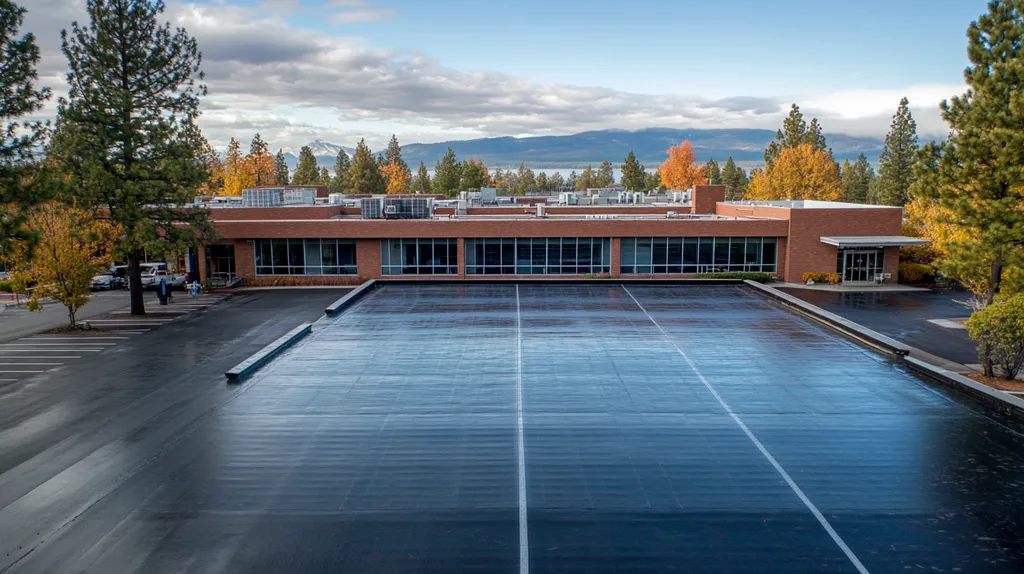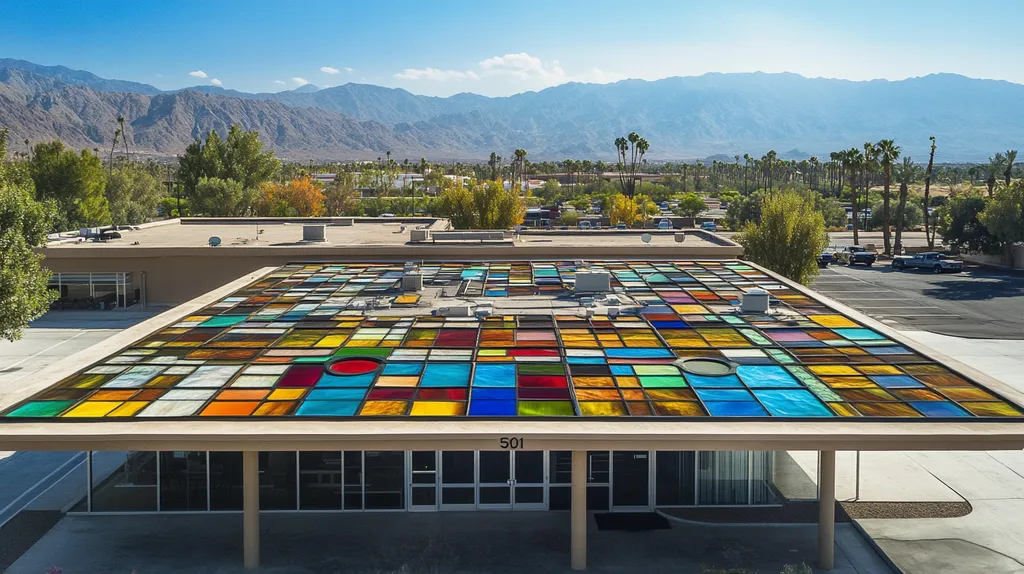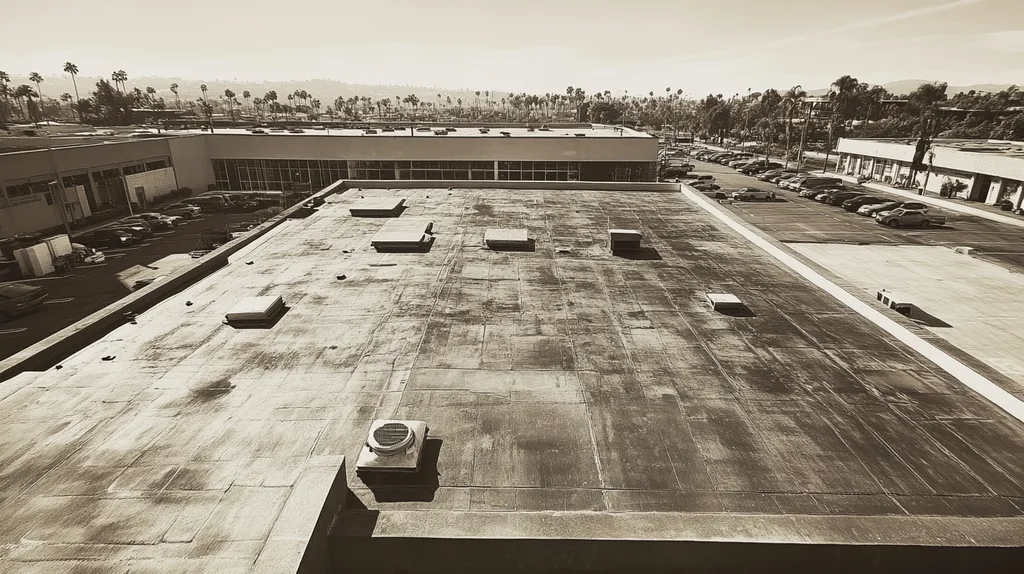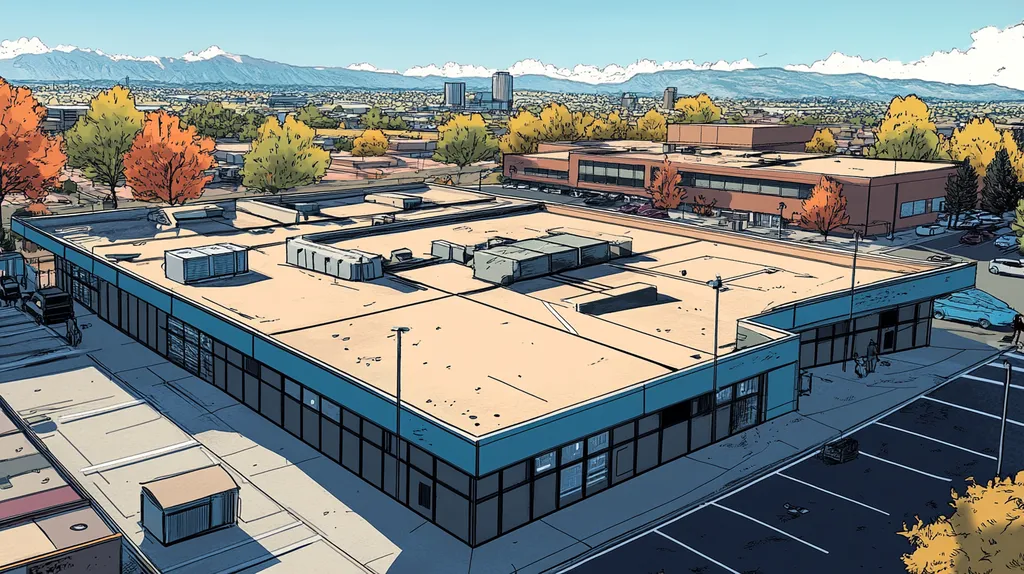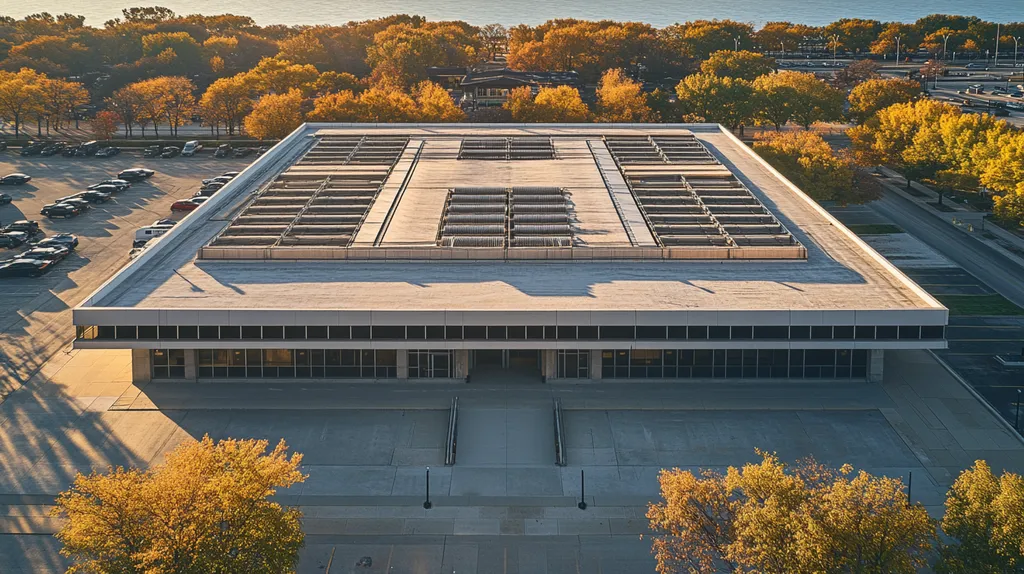Commercial building owners face mounting pressure to reduce their environmental impact, with rooftop equipment contributing up to 30% of a facility’s total energy consumption. Yet many continue relying on outdated, inefficient roofing solutions that drain resources and harm the planet.
The emergence of eco-friendly roofing technologies offers a promising path forward, with options that can slash energy costs by 25% while extending equipment lifespan.
This comprehensive guide examines critical factors facility managers must consider when evaluating sustainable roofing solutions, from performance metrics and financial implications to compliance requirements and risk management protocols.
SECTION 1: PERFORMANCE FACTORS
Facility managers are increasingly confronted with the urgent tasks of improving both sustainability and efficiency within their buildings. One of the most influential aspects of this challenge is the roofing system. Poor roofing solutions can result in skyrocketing energy expenses and adverse environmental effects. Did you know that buildings represent up to 40% of total energy consumption in the U.S.? This statistic underscores the critical need for eco-friendly roofing options that deliver strong performance. In this section, we will explore essential performance factors like energy efficiency metrics, thermal insulation, and water runoff management.
Energy Efficiency Metrics
Energy efficiency is a cornerstone of effective commercial roofing, guided by established metrics that help assess performance. The Building Energy Efficiency Standard (BEES) serves as a valuable tool for evaluating energy use in roofing systems. By incorporating reflective roofing materials, facility managers can significantly cut heat absorption, potentially lowering cooling costs by up to 20% during the sweltering summer months.
Another critical factor is the insulation rating of roofing materials. Higher R-values indicate superior resistance to heat flow, which prevents energy loss and keeps heating costs manageable. A well-insulated roof can translate into substantial savings for property owners, potentially amounting to thousands of dollars each year.
Additionally, adding solar panels to roofs can amplify energy efficiency. When properly integrated, these systems generate renewable energy and decrease reliance on conventional power sources. This investment not only aligns with sustainability initiatives but also meets the increasing consumer demand for environmentally-friendly buildings.
Key Action Items
Thermal Insulation and Heat Management
Effective thermal insulation is critical for improving overall building performance. Quality insulation materials help mitigate heat transfer, ensuring a comfortable indoor environment. This is especially important in areas with extreme temperatures, as inadequate insulation can lead to increased energy consumption and discomfort.
Moreover, innovations like cool roofs, which reflect solar radiation, can substantially reduce heat accumulation. These roofs can lower rooftop temperatures by up to 40 degrees Fahrenheit, minimizing the need for air conditioning and benefiting both the environment and operational costs.
A thoughtfully designed roof structure that promotes airflow can also help manage heat. Incorporating ventilation systems that allow hot air to escape can significantly ease cooling expenses. As such, it is vital for facility managers to focus on advanced insulation techniques to foster better heat management and support sustainability goals.
Key Action Items
Water Runoff and Stormwater Control
Effective management of water runoff is another vital aspect of eco-friendly roofing solutions. Traditional roofs may exacerbate urban flooding by overwhelming drainage systems during heavy storms. By incorporating green roof systems—roofs that feature vegetation—property managers can significantly decrease runoff as plants absorb rainwater.
In addition to green roofs, using permeable materials and implementing suitable drainage systems can promote water infiltration and reduce surface runoff. These approaches not only assist in managing stormwater but also diminish pollution risks to nearby waterways. For instance, rooftop gardens can capture up to 60% of precipitation, showcasing their value in urban environments.
Facility managers should also contemplate using cisterns to collect rainwater, which can be used for irrigation and other utilities. This dual-purpose solution enhances water conservation and lessens dependence on municipal supplies. By adopting efficient water management systems, property managers can contribute meaningfully to sustainable roofing practices.
Key Action Items
SECTION 2: FINANCIAL CONSIDERATIONS
As commercial roofing technologies advance, so do the financial implications for facility managers. Choosing eco-friendly roofing options not only boosts sustainability but also has a significant impact on property values and operating costs. In fact, research indicates that green roofs can elevate property values by as much as 20%. Understanding these financial factors is crucial for making informed, strategic roofing decisions.
Initial Installation Costs and ROI
Eco-friendly roofing solutions, including green roofs and reflective materials, often entail a higher upfront investment than conventional systems. However, these initial costs can be justified by long-term benefits, such as energy savings and an extended roof lifespan. For instance, while a green roof may cost 20% more at installation, its ROI manifests through reduced energy bills and increased property value.
Calculating ROI is vital for facility managers assessing budget options. Energy-efficient roofs, like cool roofs, diminish heat absorption and lead to lower cooling costs, allowing property managers to recover initial expenses within five to seven years. Moreover, investing in sustainable solutions can bolster a company’s brand reputation, attracting eco-conscious tenants and adding further financial value.
It’s essential for facility managers to analyze payback periods and consider the full lifecycle cost of roofing materials. Although initial expenditures may appear challenging, a data-driven approach can reveal significant financial advantages throughout the roof’s lifetime.
Key Action Items
Long-Term Energy Savings and Maintenance
Eco-friendly roofs can lead to significant long-term energy savings. For example, studies show that cool roofs can reduce energy consumption by up to 15% annually in hot climates, directly lowering utility bills and improving operational budgets. These ongoing savings can have a substantial positive impact over time.
Additionally, maintenance costs often decrease with eco-friendly materials, which tend to resist weather-related wear and tear. For instance, green roofs not only provide insulation but also lessen the burden on heating and cooling systems, extending the lifespan of both the roof and the HVAC infrastructure.
The adoption of sustainable roofing solutions also presents a competitive advantage. As energy costs rise, companies that invest in eco-friendly roofs are more likely to outperform those that don’t, ultimately enhancing profitability and market position. Regular audits can help facility managers track these advantages and optimize their roofing investments.
Key Action Items
Tax Incentives and Rebates for Eco-Friendly Roofs
Many local and federal governments offer tax incentives and rebates to encourage the adoption of eco-friendly roofing solutions. These financial benefits can significantly reduce the initial installation costs, making sustainable options more viable for property owners. Tax credits, for example, may cover portions of installation costs for green roofs or solar panels.
Furthermore, grants from state and local governments often support energy-efficient upgrades, including eco-friendly roofing materials. These resources can greatly impact budget planning for facility managers, helping them secure funds to lessen the financial burden of sustainable initiatives.
Property owners upgrading to eco-friendly roofs may also benefit from reduced insurance premiums. Insurers often provide discounts for properties that meet certain environmental standards, increasing the financial incentives for green roofing investments. Staying informed about these opportunities is crucial for maximizing financial benefits.
Key Action Items
SECTION 3: COMPLIANCE REQUIREMENTS
As facility managers explore eco-friendly roofing solutions, it’s crucial to ensure compliance with relevant building codes and environmental regulations. Ignoring these essential guidelines can result in hefty fines, project delays, or even legal issues. For instance, the International Code Council (ICC) regularly updates regulations that impact roofing choices, highlighting the importance of staying informed. In this section, we will dive into local and national building codes, key environmental regulations, and certification programs that endorse sustainable roofing efforts.
Local and National Building Codes
Building codes are foundational for ensuring the safety, functionality, and sustainability of roofing projects. In the United States, these codes are created at both local and national levels, making it vital for facility managers to familiarize themselves with applicable regulations. For example, the International Building Code (IBC) outlines guidelines about roofing materials, installation methods, and design parameters.
Overlooking local amendments can complicate projects. Many municipalities have additional regulations to tackle climate concerns, such as improving energy efficiency and managing stormwater. Partnering with an experienced contractor who understands these regulations can significantly reduce risks and enhance project success.
Moreover, certain codes address renewable energy installations, such as solar panels. Ensuring compliance safeguards against penalties and increases the building’s appeal to eco-conscious tenants.
Key Action Items
Environmental Regulations and Standards
Complying with environmental regulations is essential when implementing eco-friendly roofing solutions. Agencies like the Environmental Protection Agency (EPA) enforce standards that impact the choice of building materials and methods. Non-compliance can expose property owners to legal liabilities and environmental harm.
Regulations regarding hazardous substances in roofing materials have become stricter in recent years. Using non-compliant materials can result in legal repercussions and harm the surrounding environment, underscoring the necessity of understanding these regulations for responsible facility management.
Additionally, certain regulations address emissions, heat retention, and energy efficiency. The United States Green Building Council (USGBC) has established standards that support sustainable practices. Compliance with these standards not only meets legal obligations but also helps facility managers access financial incentives available for sustainable projects.
Key Action Items
Certification Programs for Sustainable Roofs
Certification programs create frameworks for verifying the sustainability of roofing systems. Programs like LEED (Leadership in Energy and Environmental Design) and the Cool Roof Rating Council (CRRC) assist facility managers in selecting compliant roofing solutions. These certifications affirm a roof’s performance in energy efficiency and environmental impact.
For instance, LEED awards points for adherence to sustainable practices, considering energy and water efficiency, materials used, and indoor environmental quality. Attaining LEED certification can enhance a property’s marketability significantly.
The CRRC also evaluates the solar reflectance and thermal emittance of roofing products, aiding facility managers in choosing roofs that reduce energy costs and improve indoor climate, thereby advancing sustainability objectives.
Key Action Items
SECTION 4: RISK MANAGEMENT
Understanding risk management is essential for facility managers considering eco-friendly roofing solutions. The long-term performance of a building relies heavily on the durability and effectiveness of its roofing materials. With the Global Roofing Market projected to surpass $100 billion by 2025, the urgency for resilient roofing systems grows. It’s crucial to assess the durability, weather resistance, and leak potential of eco-friendly options to avoid significant repairs and operational disruptions.
Durability and Lifespan of Eco-Friendly Materials
Eco-friendly roofing materials are designed to prioritize sustainability, but their durability can differ greatly. For instance, properly maintained metal roofs may last up to 50 years, while some green roofing options could need replacement in just 10 to 20 years.
Opting for materials that offer a longer lifespan can help minimize both costs and environmental impact. High-quality single-ply membranes, such as TPO or PVC, not only exhibit excellent durability but also enhance energy efficiency.
Facility managers should carefully consider the longevity of various eco-friendly options. Investing in high-performance materials might involve a larger initial expense but pays off through reduced maintenance and replacement needs in the long run.
Key Action Items
Weather Resistance and Climate Adaptability
Weather resistance is pivotal for roofing materials, especially given the increasing frequency of extreme weather events. It’s paramount that roofing materials endure intense winds, heavy snowfall, or scorching heat without sacrificing efficiency.
For example, reflective membranes can help keep roof temperatures down in hot climates, leading to reduced cooling expenses, while reinforced green roofing systems enhance insulation and energy savings in colder areas.
A thorough understanding of local climate conditions is crucial. Facility managers should select materials that not only bolster weather resilience but also align with their sustainability objectives. Choosing products that withstand specific climatic challenges will minimize risks and enhance long-term value.
Key Action Items
Potential for Leaks and Water Damage
Leaks pose one of the most serious risks for any roofing system, including eco-friendly roofs. Therefore, it’s vital for facility managers to comprehend how to reduce this risk effectively.
Key factors like seam integrity and material compatibility are vital for preventing leaks. For instance, green roofs necessitate adequate drainage systems to prevent water pooling, which can lead to leaks and structural damage.
Regular inspections and maintenance can help identify potential leak issues before they escalate. Facility managers should also prioritize training staff to detect early signs of deterioration or moisture intrusion.
Key Action Items
SECTION 5: OPERATIONAL PROCEDURES
Implementing eco-friendly roofing solutions goes beyond just choosing the right materials—it hinges on effective operational procedures that ensure long-term sustainability. Facility managers must understand that improper installation and inadequate upkeep can drastically reduce the lifespan of roofing systems. In fact, studies reveal that roofs lacking proper maintenance can lose as much as 25% of their useful life, leading to expensive repairs and replacements.
Installation and Maintenance Best Practices
The successful installation of eco-friendly roofing systems depends on adhering to industry best practices. Installers need to be knowledgeable about techniques that respond to local climate, which enhances energy efficiency. Proper sealing and layering techniques are essential to ensuring durability and optimal thermal performance.
Maintenance is equally critical and should be woven into the overall operational strategy. Regular maintenance schedules help catch potential issues early, allowing tasks like cleaning gutters, inspecting seals, and checking insulation to extend the life of the roof.
Using eco-friendly materials, such as low-VOC adhesives and sustainable insulation, further supports the roofing system’s environmental goals. Every decision made during installation and maintenance directly influences the roof’s performance and sustainability.
Creating a documented maintenance checklist can assist in consistently applying best practices. Such a resource guides facility managers and maintenance teams, ensuring thoroughness and accountability.
Key Action Items
Regular Inspection and Repair Protocols
Systematic inspections are vital, with bi-annual assessments recommended or more frequent checks for critical weather seasons. This proactive stance aids in identifying leaks, punctures, or material wear before problems escalate. Regular inspections not only safeguard the investment but also ensure compliance with environmental standards.
Using advanced techniques like infrared thermography or moisture meters during inspections helps locate issues that might be missed. These technologies can reveal moisture buildup and thermal inefficiencies, enabling timely interventions.
A prompt repair protocol must also be in place. Quickly addressing identified issues prevents escalation, preserving the roof’s integrity and reducing overall costs. Consistently documenting inspections and repairs enhances accountability and supports compliance efforts.
Key Action Items
Training for Facility Maintenance Personnel
Training facility maintenance teams on eco-friendly roofing practices is essential for effective operational procedures. Regular training sessions should focus on emerging materials, technological advancements, and sustainable techniques. Keeping staff updated enhances both installation and maintenance outcomes.
Leveraging industry certifications can refine the skills of maintenance teams, equipping them with knowledge to optimize eco-friendly roof performance. Programs centered on green building practices prepare personnel to face challenges related to sustainable roofing.
Encouraging a culture of sustainability within facility management boosts operational success by focusing on energy savings, water conservation, and waste reduction practices linked to roofing efforts. Moreover, evaluating training results through assessments fosters continuous improvement and keeps the staff updated on evolving eco-friendly roofing practices.
Key Action Items
SECTION 5: OPERATIONAL PROCEDURES
Choosing eco-friendly roofing materials is just the beginning; operational procedures are the backbone of ensuring lasting sustainability. If facility managers overlook proper installation or maintenance, they risk dramatically shortening the lifespan of their roofing systems. Studies indicate that roofs lacking consistent upkeep can lose up to 25% of their useful life, leading to expensive repairs and replacements.
To capitalize on the benefits eco-friendly roofs offer, it’s essential to follow proper installation and maintenance practices diligently. Regular inspections and proactive training for maintenance personnel play a critical role in a successful operational strategy.
Installation and Maintenance Best Practices
The installation process for eco-friendly roofing systems requires adherence to specific best practices to ensure longevity and efficiency. Installers should be well-trained in climate-responsive techniques that enhance energy efficiency. Proper sealing and layering are vital for maintaining durability and thermal performance.
Maintenance is not merely an afterthought; it should be a fundamental element of the operational plan. Regular maintenance checks spot potential issues before they develop into costly problems. Key tasks include cleaning gutters, checking seals, and inspecting insulation, all contributing to increased roof lifespan.
Incorporating eco-friendly materials, such as low-VOC adhesives and sustainable insulation, underscores the roof’s environmental goals. Every choice made during installation and maintenance affects the overall performance and sustainability of the system.
Creating a documented maintenance checklist can facilitate the consistent application of best practices. This tool serves as a guide for facility managers and maintenance personnel, ensuring thoroughness and accountability in all procedures.
Key Action Items
Regular Inspection and Repair Protocols
Inspections of eco-friendly roofs should be systematic, ideally happening twice a year or more frequently during critical weather periods. This proactive approach enables the early identification of leaks, punctures, or material fatigue. Regular inspections not only safeguard investments but also ensure compliance with environmental standards.
During these inspections, advanced techniques like infrared thermography or moisture meters should be employed to uncover issues that might be otherwise overlooked. These tools help detect moisture buildup and thermal inefficiencies, allowing for timely corrective actions.
Establishing a rapid-response protocol for repairs is equally important. Quick intervention upon identifying any problem minimizes damage and extends the roof’s service life. Delays in addressing issues can escalate health and safety risks, leading to higher repair costs.
Thorough documentation of all inspections and repairs fosters accountability. Keeping track of these activities supports compliance and provides valuable data for evaluating the performance of eco-friendly roofing systems over time.
Key Action Items
Training for Facility Maintenance Personnel
Investing in training for facility maintenance staff regarding eco-friendly roofing practices is crucial for operational success. Regular training sessions should cover new materials, technological advancements, and sustainable techniques. Keeping staff updated boosts the effectiveness of both installation and maintenance efforts.
Utilizing industry-recognized certifications can enhance the skill sets of maintenance teams. Programs focusing on green building practices equip personnel with the necessary knowledge to optimize the performance of eco-friendly roofs.
Moreover, cultivating a culture of sustainability within the facility management team facilitates greater operational success. Promoting initiatives focused on energy savings, water conservation, and waste reduction related to roofing work can have lasting benefits.
Lastly, assessing training outcomes through feedback or evaluations encourages continuous improvement. Adopting a culture of lifelong learning ensures that facility maintenance personnel remain ahead of evolving eco-friendly roofing practices.
Key Action Items
Looking Ahead
The adoption of eco-friendly roofing solutions represents a critical turning point for commercial property owners, with sustainable options now capable of reducing energy costs by up to 30% while extending equipment lifespan by 40%.
Yet despite compelling evidence, only 15% of commercial buildings currently utilize green roofing technologies, leaving significant opportunity for improvement across the industry.
Success requires careful attention to performance metrics, financial considerations, and compliance requirements while implementing proper risk management and operational procedures.
As environmental regulations tighten and energy costs continue rising, facility managers who fail to embrace sustainable roofing solutions risk falling behind competitors and facing increased operational expenses.
The time for action is now – the future of commercial roofing is undeniably green.
FREQUENTLY ASKED QUESTIONS
Q. What performance factors should I consider for my commercial roof?
A. Key performance factors include energy efficiency, insulation ratings, and water runoff management. Evaluating these can help improve sustainability and reduce energy costs significantly.
Q. How will eco-friendly roofing impact the value of my industrial roof?
A. Eco-friendly roofing can increase property values by up to 20%. The investment often results in lower operating costs and appeals to environmentally conscious tenants.
Q. What regulations should I comply with for a commercial roof?
A. Compliance involves local and national building codes, environmental regulations, and safety standards. Staying informed helps prevent fines and ensures project success.
Q. How do I assess the risk of my eco-friendly roofing materials?
A. Evaluate durability, weather resistance, and potential for leaks. Regular inspections and maintenance can mitigate risks and enhance longevity.
Q. What operational procedures are essential for eco-friendly roofs?
A. Proper installation, regular maintenance checks, and staff training are crucial. These practices ensure longevity and effectiveness, maximizing sustainability goals.
Q. What training should my team have for eco-friendly roofing procedures?
A. Training should cover sustainable materials, installation techniques, and technological advancements. This improves both installation and maintenance outcomes, fostering a culture of sustainability.
Q. Are there specific maintenance tactics for green roofs?
A. Key tactics include regular inspections, drainage management, and plant care. Monitoring health and functionality can prevent serious issues and extend lifespan.

